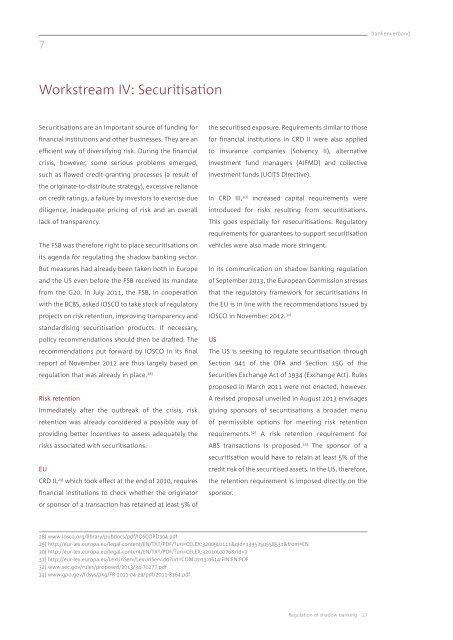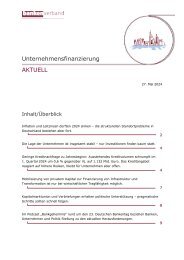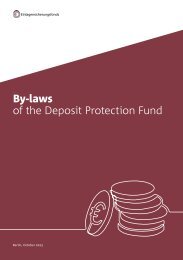Regulation of shadow banking
Shadow banking is given a large share of the blame for the financial crisis. This perception raises the question of what kind of shadow banking system should remain in place in the future.
Shadow banking is given a large share of the blame for the financial crisis. This perception raises the question of what kind of shadow banking system should remain in place in the future.
You also want an ePaper? Increase the reach of your titles
YUMPU automatically turns print PDFs into web optimized ePapers that Google loves.
7<br />
bankenverband<br />
Workstream IV: Securitisation<br />
Securitisations are an important source <strong>of</strong> funding for<br />
financial institutions and other businesses. They are an<br />
efficient way <strong>of</strong> diversifying risk. During the financial<br />
crisis, however, some serious problems emerged,<br />
such as flawed credit-granting processes (a result <strong>of</strong><br />
the originate-to-distribute strategy), excessive reliance<br />
on credit ratings, a failure by investors to exercise due<br />
diligence, inadequate pricing <strong>of</strong> risk and an overall<br />
lack <strong>of</strong> transparency.<br />
The FSB was therefore right to place securitisations on<br />
its agenda for regulating the <strong>shadow</strong> <strong>banking</strong> sector.<br />
But measures had already been taken both in Europe<br />
and the US even before the FSB received its mandate<br />
from the G20. In July 2011, the FSB, in cooperation<br />
with the BCBS, asked IOSCO to take stock <strong>of</strong> regulatory<br />
projects on risk retention, improving transparency and<br />
standardising securitisation products. If necessary,<br />
policy recommendations should then be drafted. The<br />
recommendations put forward by IOSCO in its final<br />
report <strong>of</strong> November 2012 are thus largely based on<br />
regulation that was already in place. 28)<br />
Risk retention<br />
Immediately after the outbreak <strong>of</strong> the crisis, risk<br />
retention was already considered a possible way <strong>of</strong><br />
providing better incentives to assess adequately the<br />
risks associated with securitisations.<br />
EU<br />
CRD II, 29) which took effect at the end <strong>of</strong> 2010, requires<br />
financial institutions to check whether the originator<br />
or sponsor <strong>of</strong> a transaction has retained at least 5% <strong>of</strong><br />
the securitised exposure. Requirements similar to those<br />
for financial institutions in CRD II were also applied<br />
to insurance companies (Solvency II), alternative<br />
investment fund managers (AIFMD) and collective<br />
investment funds (UCITS Directive).<br />
In CRD III, 30) increased capital requirements were<br />
introduced for risks resulting from securitisations.<br />
This goes especially for resecuritisations. Regulatory<br />
requirements for guarantees to support securitisation<br />
vehicles were also made more stringent.<br />
In its communication on <strong>shadow</strong> <strong>banking</strong> regulation<br />
<strong>of</strong> September 2013, the European Commission stresses<br />
that the regulatory framework for securitisations in<br />
the EU is in line with the recommendations issued by<br />
IOSCO in November 2012. 31)<br />
US<br />
The US is seeking to regulate securitisation through<br />
Section 941 <strong>of</strong> the DFA and Section 15G <strong>of</strong> the<br />
Securities Exchange Act <strong>of</strong> 1934 (Exchange Act). Rules<br />
proposed in March 2011 were not enacted, however.<br />
A revised proposal unveiled in August 2013 envisages<br />
giving sponsors <strong>of</strong> securitisations a broader menu<br />
<strong>of</strong> permissible options for meeting risk retention<br />
requirements. 32) A risk retention requirement for<br />
ABS transactions is proposed. 33) The sponsor <strong>of</strong> a<br />
securitisation would have to retain at least 5% <strong>of</strong> the<br />
credit risk <strong>of</strong> the securitised assets. In the US, therefore,<br />
the retention requirement is imposed directly on the<br />
sponsor.<br />
28) www.iosco.org/library/pubdocs/pdf/IOSCOPD394.pdf<br />
29) http://eur-lex.europa.eu/legal-content/EN/TXT/PDF/?uri=CELEX:32009L0111&qid=1395750558531&from=EN<br />
30) http://eur-lex.europa.eu/legal-content/EN/TXT/PDF/?uri=CELEX:32010L0076&rid=2<br />
31) http://eur-lex.europa.eu/LexUriServ/LexUriServ.do?uri=COM:2013:0614:FIN:EN:PDF<br />
32) www.sec.gov/rules/proposed/2013/34-70277.pdf<br />
33) www.gpo.gov/fdsys/pkg/FR-2011-04-29/pdf/2011-8364.pdf<br />
<strong>Regulation</strong> <strong>of</strong> <strong>shadow</strong> <strong>banking</strong> 27


















